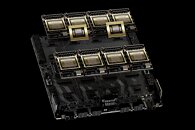- Joined
- Aug 19, 2017
- Messages
- 2,973 (1.06/day)
We know that NVIDIA's latest "Blackwell" GPUs are fast, but how much faster are they over the previous generation "Hopper"? Thanks to the latest MLPerf Training v4.1 results, NVIDIA's HGX B200 Blackwell platform has demonstrated massive performance gains, measuring up to 2.2x improvement per GPU compared to its HGX H200 Hopper. The latest results, verified by MLCommons, reveal impressive achievements in large language model (LLM) training. The Blackwell architecture, featuring HBM3e high-bandwidth memory and fifth-generation NVLink interconnect technology, achieved double the performance per GPU for GPT-3 pre-training and a 2.2x boost for Llama 2 70B fine-tuning compared to the previous Hopper generation. Each benchmark system incorporated eight Blackwell GPUs operating at a 1,000 W TDP, connected via NVLink Switch for scale-up.
The network infrastructure utilized NVIDIA ConnectX-7 SuperNICs and Quantum-2 InfiniBand switches, enabling high-speed node-to-node communication for distributed training workloads. While previous Hopper-based systems required 256 GPUs to optimize performance for the GPT-3 175B benchmark, Blackwell accomplished the same task with just 64 GPUs, leveraging its larger HBM3e memory capacity and bandwidth. One thing to look out for is the upcoming GB200 NVL72 system, which promises even more significant gains past the 2.2x. It features expanded NVLink domains, higher memory bandwidth, and tight integration with NVIDIA Grace CPUs, complemented by ConnectX-8 SuperNIC and Quantum-X800 switch technologies. With faster switching and better data movement with Grace-Blackwell integration, we could see even more software optimization from NVIDIA to push the performance envelope.

View at TechPowerUp Main Site | Source
The network infrastructure utilized NVIDIA ConnectX-7 SuperNICs and Quantum-2 InfiniBand switches, enabling high-speed node-to-node communication for distributed training workloads. While previous Hopper-based systems required 256 GPUs to optimize performance for the GPT-3 175B benchmark, Blackwell accomplished the same task with just 64 GPUs, leveraging its larger HBM3e memory capacity and bandwidth. One thing to look out for is the upcoming GB200 NVL72 system, which promises even more significant gains past the 2.2x. It features expanded NVLink domains, higher memory bandwidth, and tight integration with NVIDIA Grace CPUs, complemented by ConnectX-8 SuperNIC and Quantum-X800 switch technologies. With faster switching and better data movement with Grace-Blackwell integration, we could see even more software optimization from NVIDIA to push the performance envelope.

View at TechPowerUp Main Site | Source





